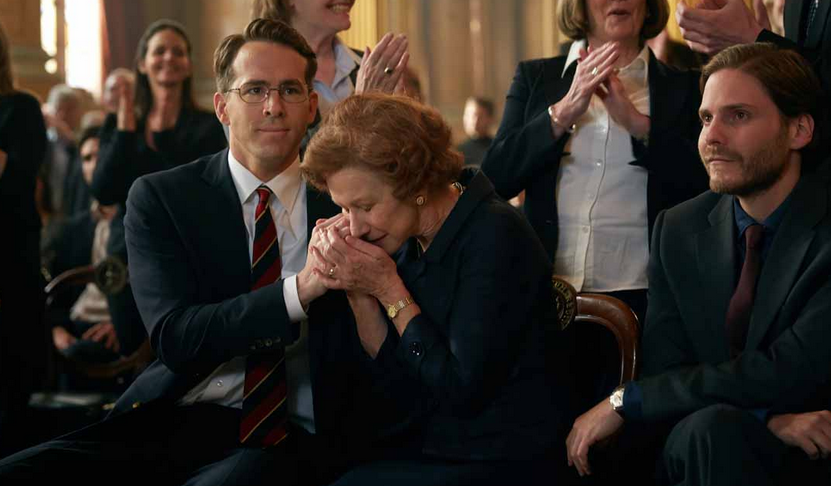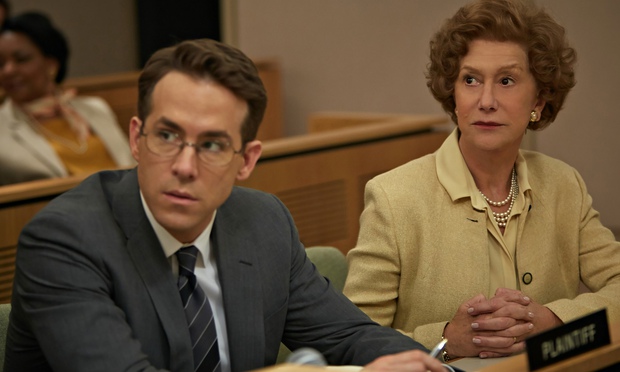The Gold War.
The trouble with films that jump between the present and the past is that one time period typically gets the short shrift. Usually, it’s the past. We are first introduced to the characters in the present, so they’re the ones we bond with – that is, if we bond with the characters at all. The characters seen in flashback are often sepia-toned, ossified versions of those characters, existing primarily to provide backstory, not the emotional heft the film frequently wants them to carry. They’re a bit like a two-dimensional painting – gorgeous, but ultimately flat.
Woman in Gold brings this painting vibrantly to life, both literally and figuratively. It’s the true story of Maria Altmann (Helen Mirren), an Austrian-born American who had to flee Austria when her country was occupied by the Nazis. The occupiers stole from her family a series of priceless paintings by Gustav Klimt, among them one called “Woman in Gold,” a glittery gold-plated portrait of her aunt Adele. They were ultimately delivered to a legitimate Austrian gallery, where they have been on display ever since. By 1998, “Woman in Gold” has long since become a cherished part of modern Austrian identity – one character calls it “the Mona Lisa of Austria” – which is all the more reason the Austrian government bristles at Maria’s attempt to reclaim the stolen property. Maria enlists the help of hard-luck Los Angeles attorney Randy Schoenberg (Ryan Reynolds), the grandson of the great Austrian composer Arnold Schoenberg, in what seems like a hopeless case against an intractable government. Digging in to the particulars of the case – including a contested will, and art restitution law that may be applied retroactively – the younger Schoenberg starts to believe Maria’s quest may not be in vain. However, it’ll take forsaking all his other cases, possibly losing his job, risking his family’s security, and forcing Maria to confront demons in her home country for them to have any shot at restoring her family’s most prized possession.
We expect great work from Helen Mirren, perhaps second only to someone like Meryl Streep these days. What we don’t expect is Ryan Reynolds really pushing his own acting limitations to conjure the type of performance that might get talked about as a career best. What we really don’t expect, though, is that both of these actors would be upstaged by actors performing smaller roles in the Austrian flashback timeline. Contrary to the conventional wisdom put forth at the top of this piece, the young Maria and the friends and family members she must abandon are the beating heart of this touching and sentimental tale. In an extreme rarity, Mirren isn’t even the best actress playing her own character, as Orphan Black’s Tatiana Maslany steps in to provide an almost discomfiting emotional centre to the young Maria. Her scenes of bracing for the change to Austria and ultimately planning her escape are no mere window dressing; they are actually full of a visceral tension, with sky-high emotional stakes. Allan Corduner is also excellent as her father, who ignored early warning signs to leave Austria, believing in his countrymen’s ability to withstand the threat. Theirs is the deepest bond in the movie, and it goes to truly wrenching places.
Director Simon Curtis smartly invests us in the events of this time period by introducing us to his woman in gold before anyone else. The film opens on Klimt painting Adele, and we acquaint ourselves with the essence of this enigmatic woman whose visage would eventually force everyone to court. (It’s worth noting that the actress who plays Adele – Antje Traue – is far more beautiful than the woman in the real painting, who earns her comparison to Mona Lisa via her plain appearance. I guess that’s Hollywood for you.) The stirring score by Hans Zimmer and Martin Phipps has its most profound usage in the flashback scenes, particularly the insidious scenes of the early Nazi occupation, enveloping everything in regal dread.
If Woman in Gold falters, and it falters very little, it’s in some of the modern-day stuff. There’s a necessarily earthbound quality to the present-day legal proceedings, less so in the scenes of modern Vienna (which feature a charming support performance by Daniel Bruhl) than in the scenes in Los Angeles. These L.A. scenes also feature a particularly limp appearance by Katie Holmes as Schoenberg’s wife, a character so underdeveloped that it would have been less distracting just to cast someone less famous in the role. Off-setting that a bit is Charles Dance as Schoenberg’s boss, who makes a much bigger impression in an equally small role, and has basically become the go-to guy for a certain brand of intimidating sternness since his career revival on Game of Thrones.
Although it has not been greeted with universal critical acclaim, Woman in Gold is the type of movie that wins gold statues. That it was released far from Oscar season suggests that the studio may have been wary of its prospects, but their caution is our reward, as we get to enjoy this handsome and solidly crafted prestige picture now, instead of waiting until December. Australian audiences may get particular enjoyment from one joke involving the confusing of the countries’ two names. There are no kangaroos in Austria, after all.
8/10
For more Reviews, click here. If you’re digging ReelGood, sign up to our mailing list for exclusive content, early reviews and chances to win big!


